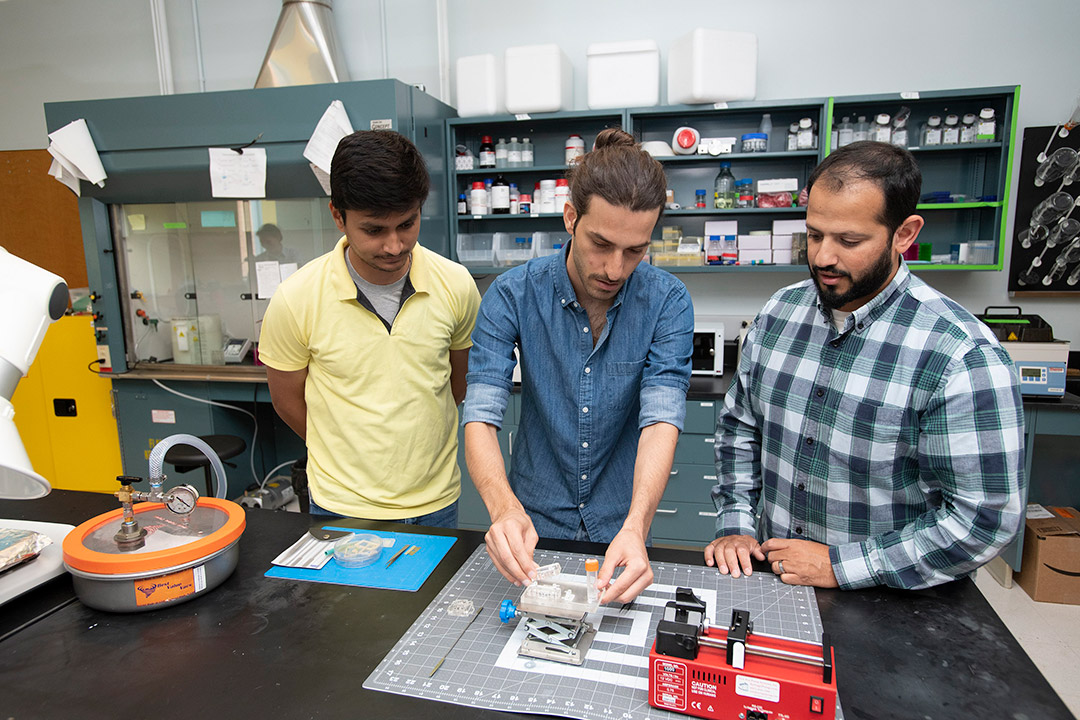RIT researchers develop new technique to study how cancer cells move
A. Sue Weisler/RIT
Vinay Abhyankar, right, assistant professor of biomedical engineering, works closely with two doctoral students, Mehran Mansouri, left, and Indranil Joshi, on research to assess cancer cell migration processes. The research team recently published findings from that research.
In tumors, cells follow microscopic fibers, comparable to following roads through a city. Researchers at Rochester Institute of Technology developed a new technique to study different features of these “fiber highways” to provide new insights into how cells move efficiently through the tumor environment.
The study, published in the journal Advanced Functional Materials, focused on contact guidance, a process where migrating cells follow aligned collagen fibers. Understanding this process is crucial, as it plays a key role in cancer metastasis, the spread of cancer to other parts of the body.
“Previous research on contact guidance, a process where cancer cells migrate along aligned collagen fibers, has been largely studied in collagen gels with uniform fiber alignment,” said Vinay Abhyankar, associate professor of biomedical engineering in RIT’s Kate Gleason College of Engineering, and study co-author. “However, the tumor microenvironment also features subtle variations or gradients in fiber alignment, and their role in cell migration has been largely unexplored. We suspected that alignment gradients could efficiently direct cell movement but lacked the technology to test the hypothesis.”
To bridge this gap, the RIT team developed a new microfluidic technique to create 3D collagen gels with tunable, tumor-like alignment gradients. These gels served as realistic miniature versions of the tumor environment and allowed the team to observe how endothelial cells and aggressive breast cancer cells responded to varying fiber patterns.
Results indicated that the endothelial cells moved faster and for longer periods of time along the direction of increasing alignment. Breast cancer cell aggregates showed biased migration on graded alignment compared to uniform alignment. These results indicate that cells may respond to alignment gradients more effectively than conventionally studied contact guidance.
“This work suggests alignment gradients may play a role in guiding cancer cell movement and offers insights into how cells may navigate efficiently through the tumor microenvironment toward blood vessels,” said Abhyankar, who leads the Biomedical Microsystems Research Lab.
The user-friendly nature of the microfluidic fabrication technique makes it accessible to a broad range of researchers. This platform opens doors to further investigations into the role of alignment gradients in different tumor models leading to a more comprehensive understanding of the biophysical cues that cells follow. It could ultimately contribute to advancing treatment strategies.
The research team members and key authors include RIT engineering doctoral students Indranil Joshi, Mehran Mansouri, Poorya Esmaili, and Richard Simon; RIT alumnus and post-doctoral researcher Adeel Ahmed; and University of Rochester collaborators Danielle Desa, Tresa Elias, and Edward Brown, associate professor of biomedical engineering and neuroscience. Funding for the work was supported by the National Institutes of Health and the National Science Foundation.













